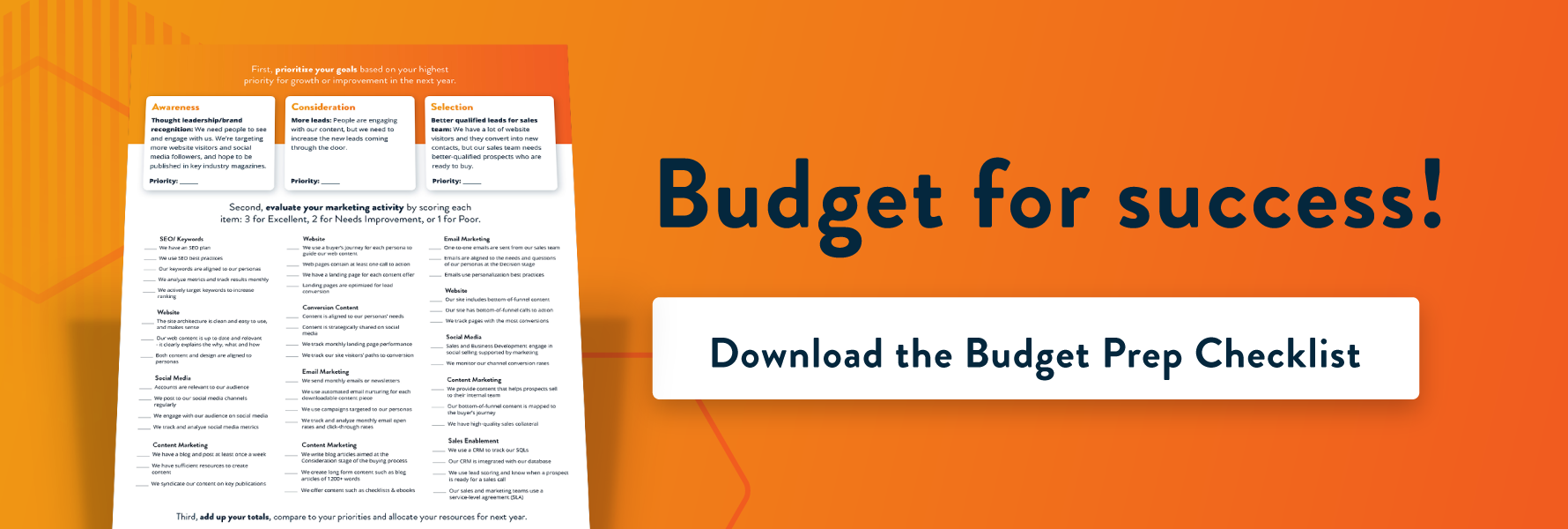
There are a lot of great reasons to start implementing inbound marketing: higher ROI than outbound marketing, more traffic to your site, greater customer delight, and greater cost-effectiveness, to name a few.
But that doesn’t mean you should start doing inbound marketing…yet. If you’re not prepared to take on the transition to inbound, you could find yourself floundering and frustrated, with an ROI that’s dwelling in the cellar.
If you’re going to succeed with inbound, make sure you have these 7 critical components in place first.
1. Clear Business Goals
Inbound marketing is a strategic, data-driven methodology that’s based on your company’s goals and your target ROI. Marketing efforts and activities will depend entirely on what you want to accomplish—how many new leads you need each quarter, your revenue goals, and your plans for scaling the business. If you start inbound without these goals in place, you’ll quickly start floundering without a sense of direction.
2. Sufficient Budget
Your marketing activities will also depend on your budget. Don’t invest in a new approach if you aren’t able to assume the costs. Your first year will be your most expensive as you develop your strategy, establish a scalable infrastructure, and populate a content library – so make sure you’re well prepared and have accurately estimated your costs.
3. Leadership Team Buy-in
If your CEO doesn’t “get” inbound marketing or hasn’t bought into it, then don’t even start inbound. You’ll find yourself constantly defending your activities and justifying your marketing decisions.
Instead, make a solid business case for inbound to win over your leadership team. Once they see the potential ROI and understand why inbound marketing can produce better results for your company, you’ll have the support you need to get started in earnest.
4. Help-First Attitude
Glengarry Glen Ross is famous for the line, “Always Be Closing.” Companies that practice inbound marketing live by the mantra, “Always Be Helping.” Inbound marketing is all about helping your customers and showing them you care, which will naturally result in a higher closing rate once you establish trust and demonstrate your ability to help solve their problems.
Today’s customers are hypersensitive to the hard sell. It’s creepy and it sets off the B.S. meter quicker than a jackrabbit on a date. Helpfulness shows your value to the customer, earns their trust, and leads the buyer farther down the sales funnel. Closing only shuts the door on your foot.
5. Willingness to Educate
A lot of companies are afraid of giving away their “secret sauce” to competitors, or that they’ll educate their customers so well that they go the DIY route instead of buying.
But 89% of customers research online before they spend any money. It’s how today’s buyers vet the businesses they buy from—they want to understand their options, trust the company, and know that they’re making the most informed decision. Companies that educate and support the buyer’s research phase will demonstrate their value, and have a higher likelihood of connecting with their customers.
Think of it this way: would you rather have your customers educate themselves on your website, or your competitors’?
6. Clear Roles and Responsibilities
If you’ve got a silo problem, you’ll have a marketing problem when you try to transition to inbound. Make sure everyone knows their role and what’s expected of them. Sales and marketing teams need to communicate and collaborate effectively, and everyone you rely on will need to get oriented on how inbound marketing works. If you don’t have clarity on these things, you will inevitably have people working at cross purposes, processes will get stuck, and vital details will fall through the cracks.
7. Long-Term Commitment to Consistent Planning & Execution
Inbound isn’t for companies that like to fly by the seat of their pants. Inbound is a slow burn that requires a long-term commitment to a smart marketing strategy and a regular planning process. Your team needs to consistently produce strong content, and maintain a regular pulse of outreach and engagement to achieve traction and maintain momentum.
You may start to see some results within a few weeks, but many companies don’t start to really see a clear return on their investment for 6-12 months. And even then, you’ll spend the next year (and beyond) fine-tuning your marketing efforts based on the data you’re collecting.
You can’t treat inbound marketing like an out-of-the-box solution, but if you take care of these seven components beforehand, you’ll have a much smoother inbound launch and you’ll enjoy stronger marketing results much sooner.
Get the latest news
Blog Topics
- Analytics
- Branding & Identity
- Budget
- Construction
- Content Marketing
- Conversion Rate Optimization
- Email Marketing
- HubSpot
- Inbound Marketing
- Lead Generation
- Marketing Strategy
- News/Events
- Paid Search & PPC
- Recruiting
- Sales & Marketing
- Sales Enablement
- Search Engine Marketing
- Search Engine Optimization
- Social Media
- Thought Leadership
- Uncategorized
- Usability
- Video Marketing
- Web Hosting
- Website Design
